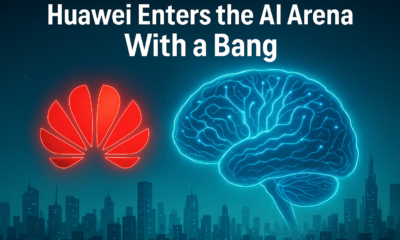Tools & Platforms
Using AI & EQ for Tech Hiring | Pipeline Magazine

By: Napoleon Rumteen
Have you ever onboarded an engineer who aced every technical assessment, impressed everyone during interviews, and seemed destined for success but quickly fell short? Within weeks, friction sets
in. Teams grow frustrated, clients feel misunderstood, and productivity slows to a crawl. It’s not as rare a scenario, yet it’s a recurring, costly inefficiency many tech companies face.
This has led to the golden age of emotional intelligence (EQ), where soft skills are the greatest asset companies should pursue, and their measure is objective and attainable. With collaboration
spanning continents and hybrid teams becoming the norm, EQ is no longer a “nice to have.” It’s a stern necessity. Technical know-how remains a necessary baseline, but emotional savvy determines
who will succeed, who will perish, and who can transform a business. Innovation isn’t driven by lines of code alone but more and more by people who know how to communicate, empathize, and adapt
under pressure.
Emotional Intelligence, the Proven Rubric for Success
While EQ might seem like a modern buzzword, its foundational importance isn’t new. Research by the Carnegie Foundation in 1918 and reported by the National Soft Skills Association showed that 85
percent of an employee’s success depends on soft skills, with technical skills accounting for only 15%. This enduring insight underscores the fundamental role EQ plays in the workplace. Over
a century later, tech leaders are rediscovering this truth in real-time.
Contemporary research reveals significant implications for organizations. Forbes reports that 89 percent of hiring misfires result from a poor employee attitude. Meanwhile, the Academy to
Innovate HR reports that 73 percent of employees left jobs due to a cultural mismatch. These data points show that EQ and cultural alignment are essential.
In a post-pandemic, hybrid-first job market, EQ matters more than ever. With less in-person connection, the ability to read people’s emotions via email, video, or internal communication platforms
like Slack has become a mission-critical skill. Understanding unspoken cues, responding thoughtfully in text, and de-escalating misunderstandings (or avoiding starting them) from a distance all
require a heightened connection to emotional intelligence.
For technology executives, these insights can be leveraged into business advantages. Teams rich in emotional intelligence demonstrate superior problem-solving capabilities, enhanced innovation,
and greater resilience to market pressures. In an industry where speed, agility, and innovation are critical, EQ-rich teams don’t just ship better products; they build stronger companies.
AI-Powered Talent Evaluation
Given the clear benefits of EQ-driven teams, the central challenge for executives is accurately assessing these elusive soft skills. Traditional assessments, from personality tests to subjective
interview processes, often introduce unintended biases or fail to provide actionable insights. However, the explosion of accessible AI technologies has transformed talent evaluation
methodologies.
So, what does EQ evaluation powered by AI look like?
Imagine a candidate immersed in an interactive, branching video scenario. In it, a teammate is dropping the ball, a client escalates an issue, and a client threatens to end their contract. The
candidate must respond, not by clicking a multiple-choice answer but by reacting just as they would in real-time. The platform captures their verbal responses, and AI scores them against EQ
traits, including empathy, adaptability, situational awareness, collaborative aptitude, and conflict resolution.
This isn’t a personality test or a resume screen. It’s a simulation of real-world dynamics—a sort of test drive—powered by intelligent systems that help hiring teams move beyond gut instinct to
data-backed insights.
Critically, this approach also reduces bias. Because AI is applied consistently to all candidates and focuses on how they respond in context, it supports DEI goals while improving the quality of
the hiring experience and the hire. It’s an emerging technology that is solving a deeply human challenge at scale.
Organizations that have incorporated EQ-driven assessments report transformative outcomes. Common benefits include reduced turnover rates, accelerated onboarding times, and improved team
dynamics. Companies also observe enhanced cultural alignment and improved satisfaction scores.
Investing in emotional intelligence assessments means fewer hiring missteps for tech executives, often leading to costly delays and stalled innovation. In high-pressure tech environments,
achieving such outcomes can elevate competitive advantages and leave competitors who don’t account for EQ far behind.
Companies already leveraging emotional intelligence data are seeing measurable retention, cohesion, and culture gains. I’ve witnessed a case where a business reduced mis-hires by 35
percent and cut onboarding time in half after adopting EQ-
Tools & Platforms
Developers turn to AI amid evolving market conditions

Developers are not only investing in technology but are also adjusting their overall strategies to navigate a competitive landscape. The report shows that 57% have diversified their portfolios to address economic uncertainty. An equal percentage are offering incentives, such as covering stamp duty costs, to facilitate transactions.
Sustainability is gaining prominence in development decisions. Nearly two thirds (63%) of those surveyed identified sustainability as a key factor for both developers and buyers.
“Developers have time and time again proven themselves to be agile and adaptive in the face of tough and fast evolving market challenges,” said Terry Woodley (pictured right), managing director of development finance at Shawbrook. “It’s no surprise to see developers increasingly making use of AI and wider technology, and shifting their priorities, to optimise business performance – and this will without doubt only become more commonplace as everyone tries to get ahead of the curve and get an edge on competitors.
“The government’s focus on housebuilding should also provide added impetus, and present opportunities for new, sustainable projects for developers to capitalise on. Speaking to a specialist lender could unlock new possibilities for those looking to accelerate their plans and future proof their business plans.”
Planning approvals in England have recently fallen to their lowest level in 13 years, fuelling doubts about the government’s ability to deliver 1.5 million new homes. Recent polling shows two-thirds of UK adults lack confidence in Labour’s housing target, while Savills has projected that the goal is unlikely to be met. In response, Prime Minister Keir Starmer introduced Extract, an AI assistant developed with Google, designed to digitise handwritten planning records and modernise the planning process.
Tools & Platforms
Heart Attack Prediction Enhanced by AI and Miniature Imaging

Thank you. Listen to this article using the player above. ✖
Want to listen to this article for FREE?
Complete the form below to unlock access to ALL audio articles.
Measurements with a miniature camera inside the coronary arteries can accurately predict whether someone will suffer a recurrent heart attack. Until now, interpreting these images was so complex that only specialized laboratories could perform it. A new study from Radboud University Medical Center shows that AI can reliably take over this analysis and rapidly assess arteries for weak spots.
A heart attack occurs when a coronary artery, which supplies the heart with blood, is blocked by a blood clot. This can occur when atherosclerosis causes artery narrowing, resulting in the heart receiving too little oxygen. Treatment typically involves angioplasty, where a cardiologist widens the artery with a small balloon, usually followed by the placement of a tiny tube, called a stent. In the Netherlands, this procedure is performed about 40,000 times per year.
Predicting recurring events
Nevertheless, about fifteen percent of patients who suffer from a heart attack experience another event within two years. To better identify vulnerable spots within the artery that can trigger new infarctions, technical physician Jos Thannhauser and physician Rick Volleberg of Radboudumc, together with their team, conducted a study. They analyzed the coronary arteries of 438 patients using a miniature camera and a specially developed AI, and followed these patients for two years.
The study shows that AI detects vulnerable spots in the arterial wall just as well as specialized laboratories—the international gold standard—and even predicts new infarctions or death within two years more accurately. What does this mean for patients? Volleberg explains: “If we know who has high-risk plaques and where they are located, we may in the future be able to tailor medication or even place preventive stents.”
Looking inside the artery wall
The miniature camera uses a technique called optical coherence tomography (OCT). Inserted through the arm into the bloodstream, it captures images of arteries using near-infrared light, visualizing the vessel wall at microscopic resolution.
“This technique is already used in clinical practice to guide angioplasty and to check whether a stent has been placed correctly”, explains Thannhauser. “It has been shown that OCT reduces the risk of new infarctions and complications. But in those cases, physicians only look at a very small part of an artery—the site of the infarction. Our study shows that this technique, combined with AI, has much greater potential to map entire vessels.”
Towards clinical application with AI
“One of the challenges with this technique is that it is extremely difficult for physicians to interpret OCT images,” says Thannhauser. That’s not surprising—each procedure produces hundreds of images. Even assessing just the stent placement is challenging. Analyzing entire coronary arteries produces far too many images to evaluate manually. “Currently, only a handful of specialized labs can interpret these images, and even they cannot review everything. Moreover, it’s too expensive and labor-intensive to implement this manually in routine clinical care.”
That is why Thannhauser’s team developed AI that can analyze all images reliably and much faster than humans. “AI can already assist physicians during stent placement with OCT,” Thannhauser explains. “Thanks to our AI, we are now a step closer to scanning entire coronary arteries for vulnerable spots in clinical practice. I do expect, however, that it will take a number of years before this becomes reality.”
Reference: Volleberg RHJA, Luttikholt TJ, van der Waerden RGA, et al. Artificial intelligence-based identification of thin-cap fibroatheromas and clinical outcomes: the PECTUS-AI study. Eur Heart J. 2025:ehaf595. doi: 10.1093/eurheartj/ehaf595
This article has been republished from the following materials. Note: material may have been edited for length and content. For further information, please contact the cited source. Our press release publishing policy can be accessed here.
Tools & Platforms
China is making AI education mandatory for kids – and it’s already rolling out in schools

Artificial intelligence is rapidly becoming part of our everyday routines. Whether it’s checking in with ChatGPT, using Face ID to unlock phones, or a subtle tweak to photos before sharing them online, AI is there behind the scenes.
With no sign of this slowing down, a school in China is moving quickly to prepare its pupils by making AI education compulsory.
In Hangzhou, Zhejiang province, authorities have introduced compulsory AI education for all primary and secondary students, aiming to get ahead of the curve and equip children with essential knowledge of the technology.
From this term, schools are reportedly expected to add at least 10 hours of AI lessons each academic year. They will have the flexibility to decide how to deliver the content – whether through an intensive week-long course or by integrating AI topics across different science and technology classes, according to South China Morning Post.
The new curriculum sets out a step-by-step approach to AI education, gradually building students’ skills from the earliest years of school.
In the first two years of primary, children will be introduced to AI through familiar tech, like smart speakers or facial recognition, and taught the basics of responsible use, with an emphasis on privacy.
iStock
By Years 3 and 4, they’ll begin using AI tools to collect and combine text, images and audio for simple projects, applying the technology to everyday tasks. Years 5 and 6 go deeper, with students learning about core concepts like decision trees, neural networks and basic algorithms.
In middle school, the focus shifts to real-world applications. Students will work through the full AI workflow, from data preparation to model training, and learn to evaluate technologies like generative AI.
By high school, the curriculum becomes project-based. Pupils will design their own AI systems and intelligent agents, applying what they’ve learnt to practical challenges.
Though still early in its rollout, the programme reflects China‘s wider goal to lead in AI – starting by making it second nature for the next generation.
You should also read…
Sign up to our free Indy100 weekly newsletter
How to join the indy100’s free WhatsApp channel
Have your say in our news democracy. Click the upvote icon at the top of the page to help raise this article through the indy100 rankings.
-

 Business4 days ago
Business4 days agoThe Guardian view on Trump and the Fed: independence is no substitute for accountability | Editorial
-
Tools & Platforms3 weeks ago
Building Trust in Military AI Starts with Opening the Black Box – War on the Rocks
-

 Ethics & Policy1 month ago
Ethics & Policy1 month agoSDAIA Supports Saudi Arabia’s Leadership in Shaping Global AI Ethics, Policy, and Research – وكالة الأنباء السعودية
-

 Events & Conferences3 months ago
Events & Conferences3 months agoJourney to 1000 models: Scaling Instagram’s recommendation system
-

 Jobs & Careers2 months ago
Jobs & Careers2 months agoMumbai-based Perplexity Alternative Has 60k+ Users Without Funding
-

 Funding & Business2 months ago
Funding & Business2 months agoKayak and Expedia race to build AI travel agents that turn social posts into itineraries
-

 Education2 months ago
Education2 months agoVEX Robotics launches AI-powered classroom robotics system
-

 Podcasts & Talks2 months ago
Podcasts & Talks2 months agoHappy 4th of July! 🎆 Made with Veo 3 in Gemini
-

 Education2 months ago
Education2 months agoAERDF highlights the latest PreK-12 discoveries and inventions
-

 Podcasts & Talks2 months ago
Podcasts & Talks2 months agoOpenAI 🤝 @teamganassi





















